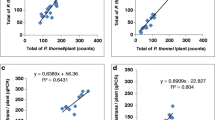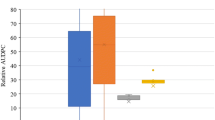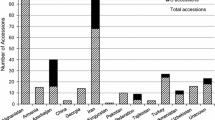Abstract
Pratylenchus thornei is widespread throughout the wheat-growing regions in Australia and overseas and can cause yield losses of up to 70% in some intolerant cultivars. The most effective forms of management of P. thornei populations are crop rotation and plant breeding. There have been no wheat accessions identified as completely resistant to P. thornei, therefore breeding programs have used moderately resistant parents. The objective of the present research was to evaluate 274 Iranian landrace wheats for resistance to P. thornei and identify accessions with resistance superior to the current best resistance source (GS50a). Plants were grown in P. thornei inoculated soil under controlled conditions in a glasshouse pot experiment for 16 weeks. Ninety-two accessions found to be resistant or moderately so were retested in a second experiment. From combined analysis of these experiments, 34 accessions were identified as resistant with reproduction factors (final population per kg soil/initial inoculum rate per kg soil) ≤1. In total, 25 accessions were more resistant than GS50a, with AUS28470 significantly (P<0.05) more resistant. The resistant Iranian landraces identified in the present study are a valuable untapped genetic pool offering improved levels of P. thornei resistance over current parents in Australian wheat-breeding programs.
Similar content being viewed by others
References
Assad MT, Dorry HR (2001) Inheritance and allelic relationships of resistances to the Russian wheat aphid in two Iranian wheat lines. Euphytica 117, 229–232. doi: 10.1023/A:1026520013040
Bhattacharya M, Jafari Shabestari J, Qualset CO, Corke H (1997) Diversity of starch pasting properties in Iranian hexaploid wheat landraces. Cereal Chemistry 74, 417–423. doi: 10.1094/CCHEM.1997.74.4.417
Bhattacharya M, Luo Q, Corke H (1999) Time-dependent changes in dough color in hexaploid wheat landraces differing in polyphenol oxidase activity. Journal of Agricultural and Food Chemistry 47, 3579–3585. doi: 10.1021/jf990041i
Berry DA (1987) Logarithmic transformations in ANOVA. Biometrics 43, 439–456. doi: 10.2307/2531826
Bonman JM, Bockelman HE, Goates BJ, Obert DE, McGuire PE, Qualset CO, Hijmans RJ (2006) Geographic distribution of common and dwarf bunt resistance in landraces of Triticum aestivum subsp. aestivum. Crop Science 46, 1622–1629. doi: 10.2135/cropsci2005.12-0463
Cox TS (1991) ‘The contribution of introduced germplasm to the development of USwheat cultivars.’ Use of plant introductions in cultivar development, part 1. Crop Science Society of America Special Publication No. 17, Madison, WI, USA.
Di Vito M, Greco N, Oreste G, Saxena MC, Singh KB, Kusmenoglu I (1994) Plant parasitic nematodes of legumes in Turkey. Nematologia Mediterranea 22, 245–251.
Ehdaie B, Baker CA (1999) Inheritance and allelism for resistance to Russian wheat aphid in an Iranian spring wheat. Euphytica 107, 71–78. doi: 10.1023/A:1003549512216
Ehdaie B, Waines JG, Hall AE (1988) Differential responses of landrace and improved spring wheat genotypes to stress environments. Crop Science 28, 838–842.
Ekboir J (Ed.) (2002) ‘CIMMYT 2000–2001. World wheat overview and outlook: developing no-till packages for small-scale farmers.’ (CIMMYT: Mexico, DF)
France RA, Brodie BB (1995) Differentiation of two isolates of Pratylenchus penetrans based on their reaction to potato. Journal of Nematology 27, 339–345.
France RA, Brodie BB (1996) Characterisation of Pratylenchus penetrans from ten geographically isolated populations based on their reaction on potato. Journal of Nematology 28, 520–526.
Greco N, Di Vito M, Saxena MC, Reddy MV (1988) Investigation on the root lesion nematode Pratylenchus thornei, in Syria. Nematologia Mediterranea 16, 101–105.
Haley SD, Peairs FB, Walker CB, Rudolph JB, Randolph TL (2004) Occurrence of a new Russian wheat aphid biotype in Colorado. Crop Science 44, 1589–1592.
Harper P (2008) ‘2007-08, principal agricultural commodities Australia preliminary.’ (Australian Bureau of Statistics: Canberra)
Hollaway GJ, Vanstone VA, Nobbs J, Smith JG, Brown JS (2008) Pathogenic nematodes of cereal crops in south-west Victoria, Australia. Australasian Plant Pathology 37, 505–510. doi: 10.1071/AP08048
Mcintosh RA, Yamazaki Y, Dubcovsky J, Rogers J, Morris C, Somers DJ, Appels R, Devos KM (2008) Catalogue of gene symbols for wheat. In ‘The 11th international wheat genetics symposium’, 24–29 August 2008, Brisbane, Australia.
Navabi Z, Shiran B, Assad MT (2004) Microsatellite mapping of a Russian wheat aphid resistance gene on chromosome 7B of an Iranian tetraploid wheat line: preliminary results. Cereal Research Communications 32, 451–457.
Orion D, Krikun J, Sullami M (1979) The distribution, pathogenicity and ecology of Pratylenchus thornei in the northern Negev. Phytoparasitica 7, 3–9. doi: 10.1007/BF02980429
Payne RW, Harding SA, Murray DA, Soutar DM, Baird DB, Welham SJ, Kane AF, Gilmour AR, Thompson R, Webster R, Tunnicliffe Wilson G (2004) ‘GENSTAT for Windows.’ 8th edn. (VSNInternational: Oxford, UK)
Pink B (2009) ‘2007-08, value of principal agricultural commodities produced, Australia preliminary.’ (Australian Bureau of Statistics: Canberra)
Pourjam E, Kheiri A, Geraert E, Alizadeh A (1999) Variations in Iranian population of Pratylenchus neglectus and P. thornei (Nematoda: Pratylenchidae). Iranian Journal of Plant Pathology 35, 23–27.
Proctor JR, Marks CF (1974) The determination of normalising transformations for nematode count data from soil samples and of efficient sampling schemes. Nematologica 20, 395–406.
Reif JC, Zhang P, Dreisigacker S, Warburton ML, van Ginkel M, Hoisington D, Bohn M, Melchinger AE (2005) Wheat genetic diversity trends during domestication and breeding. Theoretical and Applied Genetics 110, 859–864. doi: 10.1007/s00122-004-1881-8
Roberts PA (2002) Concepts and consequences of resistance. In ‘Plant resistance to parasitic nematodes’. (Eds JL Starr, R Cook, J Bridge) pp. 23–41. (CABI Publishing: Wallingford, UK)
Rohde RA (1972) Expression of resistance in plants to nematodes. Annual Review of Phytopathology 10, 233–252. doi: 10.1146/annurev. py.10.090172.001313
Seymour NP, Thompson JP (2001) New sources of resistance to root-lesion nematodes (Pratylenchus thornei) in wheats from the Middle East. In ‘Proceedings of the 10th assembly of the Wheat Breeding Society of Australia Inc.’, 16-21 September 2001, Mildura, Australia. pp. 56-59 ISBN: 0-9579469-0-2.
Shahnejat-Bushehri AA, Gomarian M, Yazdi-Samadi B (2006) The high molecular weight glutenin subunit composition in old and modern bread wheats cultivated in Iran. Australian Journal of Agricultural Research 57, 1109–1114. doi: 10.1071/AR06015
Sheedy JG, Thompson JP (2008a) Identifying resistance to root lesion nematode (P. thornei) in the genera Triticum and Aegilops, 1998. Plant Disease Management Reports (online). Report 2: N006. (The American Phytopathological Society: St Paul, MN) doi: 10.1094/ PDMR02
Sheedy JG, Thompson JP (2008b) Confirmation of resistance to root lesion nematode (P. thornei) in the genera Triticum and Aegilops, 1999. Plant Disease Management Reports (online). Report 2: N004. (The American Phytopathological Society: St Paul, MN) doi: 10.1094/PDMR02
Sheedy JG, Thompson JP (2008c) Identifying resistance to root-lesion nematode in Iranian landrace wheat, 1999. Plant Disease Management Reports (online). Report 2: N005. (The American Phytopathological Society: St Paul, MN) doi: 10.1094/PDMR02
Sheedy JG, Thompson JP (2008d) Iranian landrace wheat proves to be a valuable source of resistance to root-lesion nematode, 2002. Plant Disease Management Reports (online). Report 2: N003. (The American Phytopathological Society: St Paul, MN) doi: 10.1094/ PDMR02
Sheedy JG, Smiley RW, Easley SA, Thompson AL (2007) Resistance reaction of Pacific Northwest spring wheat and barley cultivars to root-lesion nematode (P. neglectus), 2007. Plant Disease Management Reports (online). Report 1: CF022. (The American Phytopathological Society: St Paul, MN) doi: 10.1094/PDMR01
Sheedy JG, Raupp WJ, Thompson AL, Smiley RW (2008a) Resistance to root lesion nematodes (P. thornei; P. neglectus) of Chinese Spring x Aegilops speltoides addition lines, 2007. Plant Disease Management Reports (online). Report 2: N038. (The American Phytopathological Society: St Paul, MN) doi: 10.1094/PDMR02
Sheedy JG, Smiley RW, Easley SA, Thompson AL (2008b) Resistance of Pacific Northwest winter wheat and barley cultivars to root-lesion nematode (P. neglectus), 2007. Plant Disease Management Reports (online). Report 2: N016. (The American Phytopathological Society: St Paul, MN) doi: 10.1094/PDMR02
Skovmand B, Reynolds MP, DeLacy IH (2001) Mining wheat germplasm collections for yield enhancing traits. Euphytica 119, 25–32. doi: 10.1023/A:1017528025501
Starr JL, Bridge J, Cook R (2002) Resistance to plant-parasitic nematodes: History, current use and future potential. In ‘Plant resistance to parasitic nematodes’. (Eds JL Starr, R Cook, J Bridge) pp. 1–22. (CABI Publishing: Wallingford, UK)
Thompson JP (1990) Treatments to eliminate root-lesion nematode (Pratylenchus thornei Sher and Allen) from a vertisol. Nematologica 36, 123–127.
Thompson JP (2008) Resistance to root-lesion nematodes (Pratylenchus thornei and P. neglectus) in synthetic hexaploid wheats and their durum and Aegilops parents. Australian Journal of Agricultural Research 59, 432–446. doi: 10.1071/AR07222
Thompson CH, Beckman GG (1959) ‘Soils and land use in the Toowoomba area, Darling Downs, Queensland. Soils and land use series No. 28.’ (CSIRO: Melbourne)
Thompson JP, Haak MI (1997) Resistance to root-lesion nematode (Pratylenchus thornei) in Aegilops tauschii Coss., the D-genome donor to wheat. Australian Journal of Agricultural Research 48, 553–559. doi: 10.1071/A96167
Thompson JP, Brennan PS, Clewett TG, Sheedy JG, Seymour NP (1999) Progress in breeding wheat for tolerance and resistance to root-lesion nematode (Pratylenchus thornei). Australasian Plant Pathology 28, 45–52. doi: 10.1071/AP99006
Thompson JP, Sheedy JG, Seymour NP, Clewett TG, Mason LR, Sheppard JA, Banks PM (2001) Advances in breeding wheat for tolerance and resistance to Pratylenchus thornei and P. neglectus for the northern region. In ‘Proceedings of the 10th assembly of the Wheat Breeding Society of Australia Inc.’. 16–21 September 2001, Mildura, Australia. pp. 123-127 ISBN: 0-9579469-0-2.
Thompson JP, Owen KJ, Stirling GR, Bell MJ (2008) Root-lesion nematodes (Pratylenchus thornei and P. neglectus): a review of recent progress in managing a significant pest of grain crops in northern Australia. Australasian Plant Pathology 37, 235–242. doi: 10.1071/ AP08021
Trudgill DL (1991) Resistance to and tolerance of plant parasitic nematodes in plants. Annual Review of Phytopathology 29, 167–192. doi: 10.1146/ annurev.py.29.090191.001123
Vanstone VA, Hollaway GJ, Stirling GR (2008) Managing nematode pests in the southern and western regions of the Australian cereal industry: continuing progress in a challenging environment. Australasian Plant Pathology 37, 220–234. doi: 10.1071/AP08020
Whitehead AG, Hemming JR (1965) A comparison of some quantitative methods of extracting small vermiform nematodes from soil. The Annals of Applied Biology 55, 25–38. doi: 10.1111/j.1744-7348.1965.tb07864.x
Zadoks JC, Chang TT, Konzak CF (1974) A decimal code for the growth stages of cereals. Weed Research 14, 415–421. doi: 10.1111/j.1365-3180.1974.tb01084.x
Zwart RS, Thompson JP, Godwin ID (2004) Genetic analysis of resistance to root-lesion nematode (Pratylenchus thornei) in wheat. Plant Breeding 123, 209–212. doi: 10.1111/j.1439-0523.2004.00986.x
Author information
Authors and Affiliations
Corresponding author
Rights and permissions
About this article
Cite this article
Sheedy, J.G., Thompson, J.P. Resistance to the root-lesion nematode Pratylenchus thornei of Iranian landrace wheat. Australasian Plant Pathology 38, 478–489 (2009). https://doi.org/10.1071/AP09030
Received:
Accepted:
Issue Date:
DOI: https://doi.org/10.1071/AP09030




